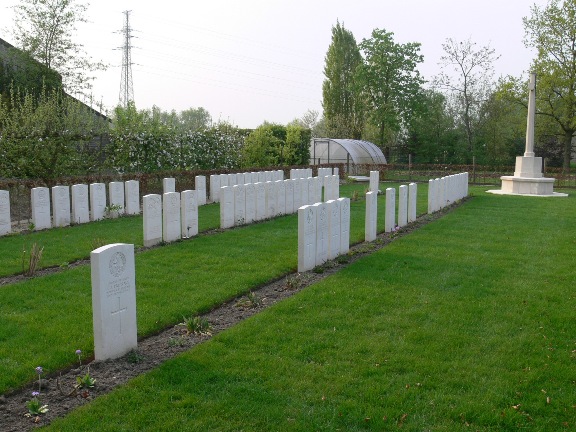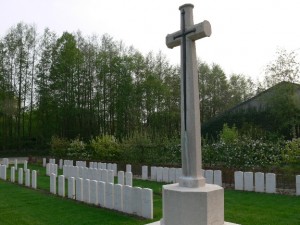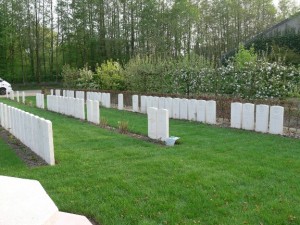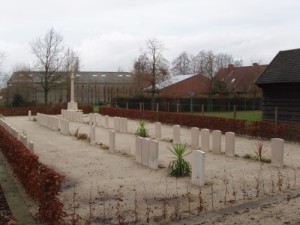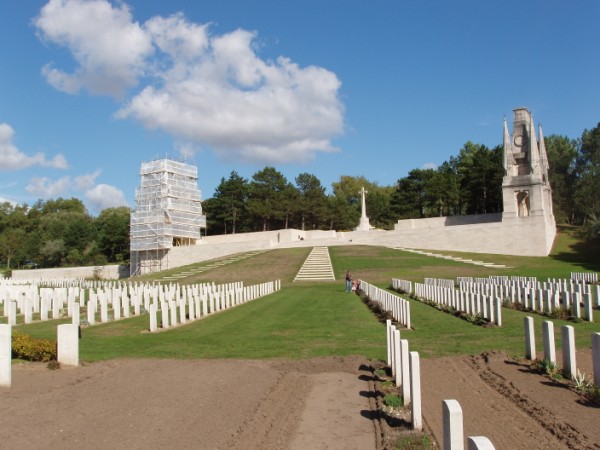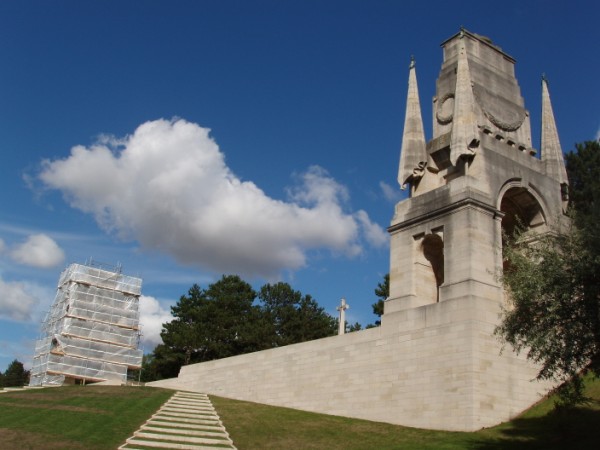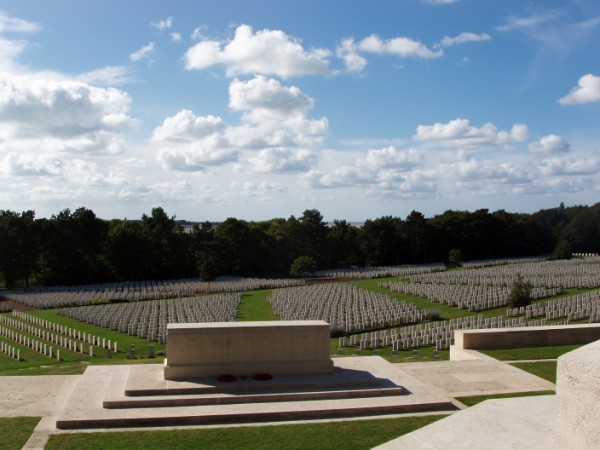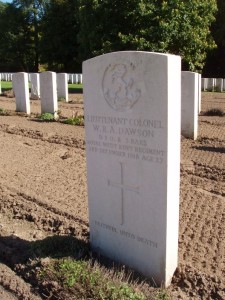Posts Tagged ‘cemetery’
Railway Chateau Cemetery – now returned to lawn
I was pleased to receive some photos of Railway Chateau Cemetery near Ypres from my brother, Mark Banning of MGB Tours. This was one of the cemeteries that the CWGC chose to conduct their climate charge trial on. Sadly this meant that for a period of eighteen months the cemetery lost its turf which was replaced with a most unsatisfactotry form of hard standing. It was telling how the difference in ground surface had such an effect on the architects vision of the cemetery – no longer a peaceful English garden but a messy patch of neglected ground. Even the plants seemed to suffer.
I wrote back in February that the cemetery was to be returned to tuft and can now post some images from last week.
Thank goodness this experiment has ended. Whilst I completely understand the need for the CWGC to be at the vanguard of horticulture with regard to climate change, it was pretty clear at the outset that this experiment was not well regarded. The work seemed to have been done in such a slapdash way – quite unlike the usual CGWC gardening and landscaping.
Some other images below including how the cemetery looked during its experiment.
Railway Chateau Cemetery to be returned to lawn
I have just heard that the dreadful CWGC experiment at Railway Chateau Cemetery outside of Ypres where they removed the turf and put down some sort of hard standing has been scrapped. In fairness to the CWGC they always said it was an experiment but I am sure after the comments on various war forums plus those left in the visitor’s book that they were assured hadn’t been greeted with anything other than distress. Defintely a thumbs down from all who had written in the visitors book when I was there. Thank goodness that common sense has prevailed. I will visit again later in the year and post a picture then. A description of my visit in December 2009 can be read here: CWGC Climate Change Trials.

Railway Chateau Cemetery in December 2009. Spring 2011 will see a welcome return of turf to this quiet little cemetery.
This news was from the Western Front Association and the extract from their website can be read below. Link here also: WFA Article on Railway Chateau being returned to lawn.
CWGC News: Railway Chateau Cemetery to be returned to lawn
The Commonwealth War Graves Commission has been conducting climate change demonstrations at four of its cemeteries in northern Europe.
One of the primary aims of the demonstrations has been to elicit public feedback on the different approaches taken. In November 2009, an online survey was developed for this purpose, whilst the CWGC also monitored comments in the Visitor Books at each of the four cemeteries.
Support for the Commission’s work on climate change, and the approaches taken at three of the cemeteries, was strong but there was little enthusiasm for the hard landscaping solution adopted at Railway Chateau.
Although dry landscaping is commonly and successfully employed by the Commission at cemeteries where grass cannot be grown or maintained – usually due to a lack of a regular water supply – this was the first time it was demonstrated at a cemetery in northern Europe.
As a result of the feedback received, Railway Chateau will be re-established as a typical lawn cemetery in the spring of 2011.
The cemetery will remain part of the climate change demonstrations with the CWGC using drought-tolerant plants in the borders and a drought tolerant grass mix – similar to the approach taken at Oostduinkerke Communal Cemetery in Belgium. The demonstrations will run for another four years and the CWGC will continue to monitor and update the public on the outcomes.
Etaples Military Cemetery
On way back from family holiday in the Dordogne we stopped the final night at Le Touquet. Being so close to Etaples I couldn’t resist a visit to the huge military cemetery there, the largest in France with 11,479 casualties buried here. This is only marginally smaller than the number buried at Tyne Cot but I would venture it receives a fraction of the number – there were only a couple of other visitors whilst we were there. I have been a number of times before on battlefield trips and have always battled the rain and cold but was blessed with wonderful weather on Saturday. It looks like maintenance work is being carried out on the entrance structure and some areas were being resown with grass seed. It really is well worth a visit and is especially poignant that one can see the sea from the cemetery entrance. For so many men it was a case of so near and yet so far.
In fact, next time I am heading to the Somme I think I will take the A16 this way from Calais – via Wimereux and Etaples and then stopping at Montreuil to see where Sir Douglas Haig had his headquarters and then continue down to Amiens and into the battlefields that way. It is a fascinating route and surprisingly pretty too!
Whilst at Etaples I really wanted to pay my respects at the grave of Lt Colonel William Dawson, DSO & 3 Bars, 6th Queen’s Own (Royal West Kent Regiment) who is buried in XLV. A.10. Dawson was quite a man – I understand that he refused promotion above the level of battalion command and was entitled to wear seven wound stripes. He is mentioned in Alan Thomas’ wonderful book, ‘A Life Apart’. The one bit of that book that always struck me was when Thomas referred to Dawson’s bravery and reaction to shellfire. Sadly Dawson was hit by shellfire in October and died in December 1918. Truly a brave man.
Alan Thomas wrote:
I never believed in a man bearing ‘a charmed life’. If I had, I should have put Dawson high on the list. So, I think, would most of the battalion. For when you were with Dawson you felt safe. Often I walked by his side along the stickiest of roads and through the unhealthiest of trenches, and because he was with me I did not feel afraid. Had I been alone, I could scarcely have dared to creep along even on all fours. But he would stride buy generic alprazolam online ahead, with his pipe in his mouth, as confidently as if he had been walking down Bond Street. (As a matter of fact, he would never have been seen in Bond Street with a pipe on: his ‘West End’ standards would have seen to that.) Did he know what fear was? I often wondered. Then one day, in 1917, I came across him alone. Our lines were being heavily bombarded and I was going along my sector to see if the men were all right. Turning into one of the bays, I ran into Dawson. He was standing in an odd position: instead of leaning with his back to the side of the trench, he was standing facing it, gripping the mud wall with crooked fingers. His expression was drawn, as though he were in pain. On seeing me, he relaxed and tried to laugh. It was the laugh of a nervous, frightened man. I gazed at him, wondering what had happened. For a moment I thought he might have been wounded.
‘Are you hit, sir?’ I asked.
‘Hit?’ He repeated the word as though he did not know what I meant. Then he went on: ‘I suppose it’s never occurred to you that I could be frightened?’ He was looking at me squarely and had got possession of himself again. I said the idea had never occurred to me.
‘Do you think I like these bloody bombardments,’ he went on. I told him that I didn’t think that, either, but that I had never seen him afraid.
‘Well, you have now,’ he observed. ‘It was because I was afraid that I was clinging to this bloody trench.’
‘I don’t blame you,’ I said. ‘I’m frightened myself.’
‘But when I’m with other people,’ he said, ‘I don’t show the fear I feel, that’s all. Nor do you have to, either.’
‘No, sir,’ I said, feeling proud that he should seem to place me in the same category as himself: that is, the category of the really brave who feel afraid but do not show it.
‘But I don’t mind telling you now –’ he added, but evidently thought better of it, for he broke off and with a gruff, ‘Come on’, led the way along the trench in his usual confident way. And, walking behind him, I felt safe.
Well, that was Dawson – or some idea of him, at least.
Copyright: Alan Thomas, A Life Apart, Victor Gollancz, London, 1968.

